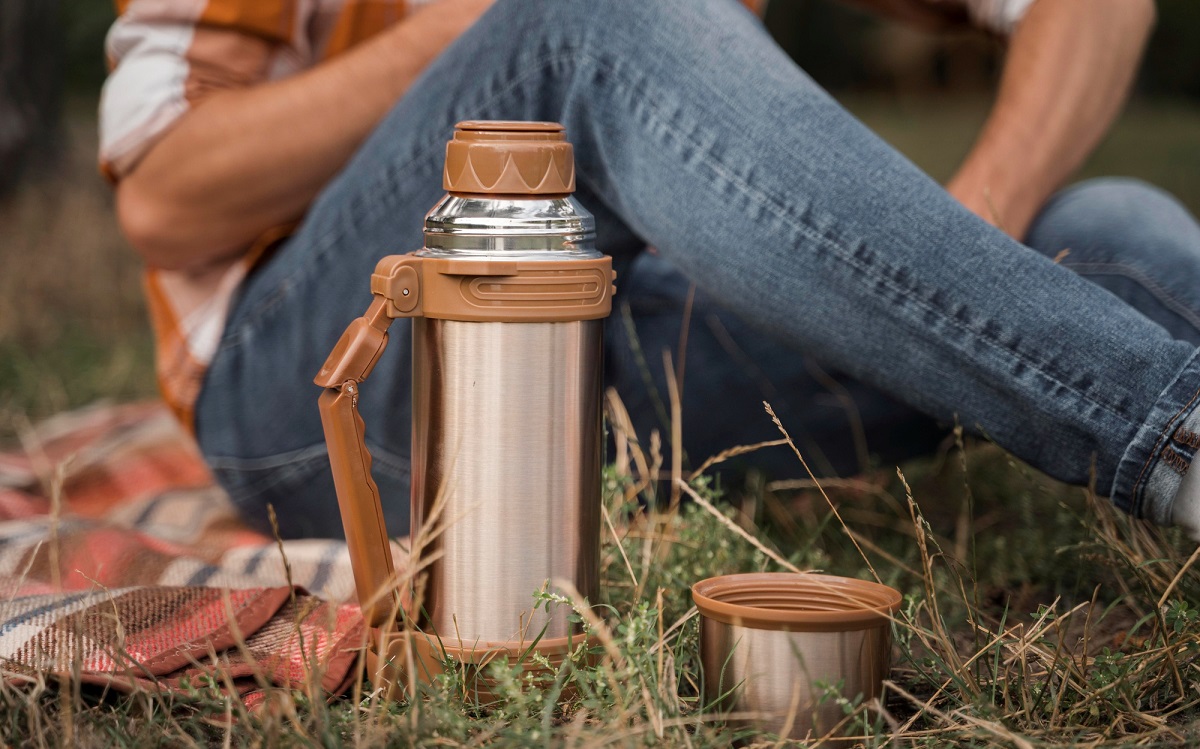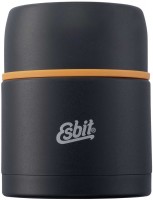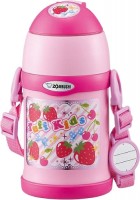How to choose a thermos
We independently test the products and technologies that we recommend.

1. Type
Modern thermoses are very versatile accessories that are relevant all year round. The opinion that these solutions are only for hiking or cold seasons is wrong. Due to their insulating properties, thermoses can maintain the original temperature of various contents. Yes, in winter these will be warm drinks (tea, coffee, etc.), but in the summer heat - cold ones (water, fruit drink, refreshing cocktail).
In case of force majeure, such as long power outages, a thermos can become a real lifesaver. In such circumstances, it is ready to partially replace both an electric kettle (it will keep boiling water hot) and a refrigerator (for example, it will protect ice cubes from melting quickly). The versatility of use is also confirmed by the variety of thermos types. Let's look at the main variations and their optimal use scenarios:

4 – Food thermos. 5 – Thermos jug. 6 – Children’s thermos.
- Classic thermos. These are containers of predominantly cylindrical shape with a small base and a narrow neck. They are ideal for use with pure liquids without additives (tea leaves, pieces of fruit, etc.). Classic thermoses are suitable for various purposes - from tourism and trips of varying duration to everyday use (at work, school, at home, etc.).
- Thermos mug. These are relatively small containers for individual use and drinking drinks "on the go". As a rule, for ease of use, a lid with a drinking system (drinker) is offered. Unlike a regular cup or mug, this one also provides additional thermal insulation, but, as a rule, the temperature is not maintained for a very long time. Thermos mugs are ideal for everyday use - on the way to the office or to school, when walking in the park, etc.
- Thermos flask. These are medium-capacity models that visually resemble hiking flasks or sports bottles, but with additional insulation. These thermoses are similar to both classic solutions (in shape and volume) and thermo mugs (they have a sippy cup for convenient drinking straight from the vessel). Thermos flasks are a good choice for use during training or on short trains, but in general they are almost as versatile as regular thermoses.
- Food thermos. Such a product often has a wide neck, which adds convenience when loading (and unloading) solid products. Plus, this design feature simplifies maintenance. These models are usually larger and more capacious, and can be equipped with spoons or containers(containers). A food thermos will allow you to take lunch with you to work or school, food on the road, and can also be useful for camping or hiking.
- Thermos jug. In fact, this is a larger and more capacious variety of classic vessels. Almost always there is a handle, a spout or even a pump (a pump for supplying liquid without tilting the container). The latter feature brings the thermos jug closer to such electrical appliances as thermo pots, but they have their own heating element. It is better to use a thermos jug at home when you do not want to constantly heat (or cool) drinks. Such a product can also be used in camping (in a shared kitchen) or in catering (banquet service).
- Children's thermoses. Such models are considered a separate variety due to their characteristic design (bright colors and prints) and small volume - usually up to 0.5 liters. Children's thermoses for the little ones can have drinking cups in the form of tubes. It is logical that these are solutions for children who go to kindergarten or elementary school.
So, if you plan to take food with you to shift work, then you need to consider a food thermos. If you like to go to To Go coffee shops, then a thermos mug is the best option. And it will also be a manifestation of concern for the environment (you will refuse disposable cups). A thermos jug is suitable for home, and a thermos flask is suitable for training. Well, for a hike and the most universal use, it is worth looking at classic solutions.
2. Volume
The size and weight, as well as the cost, directly depend on the capacity of the thermos. All other things being equal, the larger the volume, the higher the price tag. Capacity also affects the insulating properties. In a larger flask, warm contents do not cool down longer (and cold contents do not heat up). But keep in mind that this rule is only true for full filling. If the thermos is half empty, the temperature will change faster. That is, taking a volume in reserve is not very advisable.

What capacity do you need? It depends on your needs, and it’s easy to calculate based on a standard portion of drinks of 250 or 300 ml. Below we have provided basic recommendations for choosing the volume of a thermos:
- up to 0.5 liters. This is the best choice for individual use. Many thermo mugs and flasks, children's and classic thermoses have this capacity. This capacity is good for drinking on the go, attending a workout or jogging, for a short trip;
- from 500 ml to a liter. In fact, this is an average volume, and, for example, liter thermoses are generally considered classic. Such capacity is more common in regular and food models, as well as flasks. Such capacity is suitable for one person for daily use or short trips, and for a family - for a weekend walk in the park;
- from 1000 to 1500 ml. This capacity can be classified as "above average". It is no longer typical for thermos flasks and mugs. This volume is recommended for business trips or hikes. It is also a good option for family use, for example, on a picnic or on short trips;
- from 1.5 to 2 l. This is a large volume, typical for food and regular thermoses, as well as thermal jugs. Such capacity can be recommended for group travel, long family outings, and also for home use;
- from 2 liters. Such containers are typical for thermos jugs, but sometimes they are also found among classic models. This volume undoubtedly determines the large dimensions of the product and its solid weight (without contents), so it is hardly convenient for hiking. But the most capacious thermoses are good for long family trips by car, in camping camps, and also at home.
3. Insulating properties
The insulating properties of a thermos directly affect how well it copes with its main task - maintaining temperature. This is very important for all types of thermoses, with the exception of perhaps thermos mugs, where a couple of hours is quite enough.

The main problem with choosing models based on insulation properties is that not all manufacturers provide any specific information on this matter. And if there are no figures, then you need to look at the following:
- Insulation technology. The most popular and effective today is a double-walled design with a vacuum layer. If it is present, the product will maintain the temperature at a decent level. Some models, including simple food thermoses and thermo mugs, do not use vacuum technology, but a heat-insulating gasket, here the period of maintaining the original temperature regime will be shorter.
- Neck diameter. Models with a narrow neck have better thermal insulation, because in this case heat loss is minimized.
- Lid tightness. Let's say that a thick threaded plug, all other things being equal, is better in terms of insulation than a drinker with a thin plastic latch.
- Reviews. For popular thermoses, the operating experience of other users gives a hint about the thermal insulation characteristics.
In cases where information about insulation is provided by the manufacturer, one of two approaches to providing information is used:

- The time of heat and/or cold preservation in hours is indicated. This data is somewhat generalized, because there is no precise understanding of what temperatures are considered heat and cold. But even with this information, different models can be compared with each other.
- Specific temperature values of the contents are indicated at different time intervals - 6, 12 and 24 hours. This information is given after factory tests with boiling water, and the tests are carried out at room temperature. So, if after 24 hours the liquid remains hotter than 50 °C, then we can say that the thermos really keeps the heat for a long time. By the way, here is a selection of thermoses with long-term temperature retention. And with cold in practice the situation will be even better: in tandem with ice cubes we can talk about several days of maintaining the temperature regime.
By the way, regardless of whether there is information about the insulating properties of the thermos or not, after purchasing it, we recommend conducting your own tests:
- Vacuum technology can be easily tested even in half an hour or an hour. If you pour boiling water into the flask, the body should not heat up from the outside, as it should cool down when filled with cold water.
- You can run a longer test and measure actual temperatures over different time periods.
4. Materials of manufacture
As mentioned earlier, most modern thermoses have a two-layer design. At the same time, different materials can be used for both the inner flask and the outer body. Let's look at the options that are available today. Let's start with the flasks:
- Stainless steel. The most popular choice today. Combines strength, reliability and durability. And since food grade stainless steel is used for the flask, they guarantee safe contact with food and minimal impact on the taste and smell of the contents. The thermal conductivity of steel is high (insulation is not great), but in tandem with vacuum technology, everything works well.
- Glass. The main advantages of such a flask are 100% inertness to the contents (no effect on smell and taste) and good insulation against the background of steel (especially when using mirrored internal surfaces). However, glass is very fragile, it must be protected from falls and impacts, that is, such a thermos is not suitable for extreme conditions.
- Plastic. A rarely used material for flasks. It is cheap and has poor thermal conductivity (it holds the initial temperature well), but is not 100% inert when in prolonged contact with hot substances. A plastic flask is found in some thermo mugs and budget food thermoses.
The outer walls are most often made of stainless steel, which increases impact resistance and overall reliability. To better preserve the marketable appearance, the metal can be covered with powder paint, and for a secure hold in the hand (protection from slipping), it can be supplemented with rubberized inserts. There are also models with a plastic case (usually paired with a glass flask). Such thermoses are cheaper, but they lose their original marketable appearance faster.

In general, the tandem of a steel flask and a metal outer casing looks like the best solution also because vacuum technology requires durable materials. In case of depressurization, the layer will fill with air, and the insulation properties will sag significantly. This risk is less critical for jugs and thermoses that will be used at home, and not on trips.
5. Lid or cork?
The convenience of use, tightness and the above-mentioned insulation properties depend on the method of closing (opening) the thermos. It is definitely worth paying attention to this design element when choosing. In addition, there are many variations of lids today:

4 – Drinking lid. 5 – Pump lid.
- Screw cap. One of the most popular in general, and also a typical option for classic thermoses. The screw cap perfectly protects against accidental spillage of liquid, is simple and easy to use, and is very durable (it is probably possible to strip the thread, but you will have to try). Previously, such screw caps had a clear disadvantage - not the most convenient procedure for pouring a drink into mugs - only after complete removal. Now this disadvantage is leveled in many models due to special grooves in the lid design: they provide the ability to supply liquid when partially unscrewed.
- Valve. This is actually an improved version of the screw cap. It also screws on, but has a push valve on top: it simplifies pouring drinks into cups and reduces heat loss. However, the narrow opening of the valve can become clogged with tea leaves or pulp.
- Flip-up lid. This is a popular option for thermos flasks and children's thermoses. This lid can be used with one hand. At the press of a button, the "top" flips up and opens access to the pouring hole, drinking system or straw (depending on the model). Flip-up lids usually have lower insulation properties and overall reliability, and their dimensions are larger than their counterparts.
- Drinking bowl. The most popular option for thermos mugs. And, for example, for thermos flasks it can be combined with a hinged lid. The drinking system is convenient for drinking from the main container. To ensure tightness, various mechanisms with buttons, latches, levers, etc. can be used. The insulating properties of drinking bowl lids are the lowest, but for thermos mugs this is often not critical.
- Other lids, including blind ones, stoppers and pumps. The latter are found only in thermos jugs and allow you to pour liquid into cups without tilting the container - usually by pressing a button-spout.

Note that lids can be solid (monolithic) or composite (collapsible). Which is better? Depends on the application scenario. Let's say a solid lid is optimal for a thermos mug so that some parts are not lost in a hurry. But a collapsible design, all other things being equal, should simplify maintenance and increase repairability (if spare parts are available for sale).
In general, if reliability and tightness are a priority, then the best choice is a screw cap or valve. Folding designs are suitable for convenient use, and drinking bowls are suitable for easy drinking directly from the thermos. Plus, do not forget that a classic thermos usually also has an outer lid, which is almost always ready to serve as a mug.
6. Additional features of thermoses
What else should you pay attention to before buying? Here are some practical tips when choosing a thermos:
- tea fans should consider models with a tea strainer. Such an accessory is found in thermo mugs and regular thermoses;
- Typical options for extended equipment include a cover, an additional cup (for classic models) or a bowl (for food). Food thermoses may also come with a spoon or containers;
- If you choose a large-volume product, make sure it has a handle or shoulder strap for carrying;
- thermos flasks and other variations are sometimes supplemented with carabiners that allow you to fix the thermos on a backpack;
- For visual control of the temperature of the contents, some models are supplemented with a profile indicator. Most often, this is a display showing the current value in degrees, but sometimes there is a special chameleon coating (changes color);
- when choosing thermo mugs and small-volume thermoses, it is a good idea to consider the diameter of the base of the body. Values up to 7 cm ensure compatibility with almost any car cup holder;
- If you don’t like labor-intensive maintenance, then look for a product that can be washed in a dishwasher or with a fairly wide neck for easy cleaning of the inner walls of the flask.
7. Brands and prices
As a rule, the cost of a thermos directly depends on the materials used (metal is traditionally more expensive), volume, duration of temperature preservation, complete set and additional features. And only then comes the so-called brand surcharge, although it actually guarantees overall quality and good insulating properties.
The top manufacturers of thermoses include the following brands: Stanley, Zojirushi, Thermos. By the way, these brands provide an extended warranty on their products. Let's say Stanley has a lifetime warranty, while Zojirushi and Thermos have a 5-year warranty, respectively, on the vacuum insulation technology and on the product in general.
Middle class brands are Esbit, Tefal, Contigo, Kambukka, Primus, Tatonka.
Among budget solutions we can highlight Noveen, Xiaomi, Maestro.
In general, we recommend first, based on your needs, choosing the type of thermos and its volume. Then you can and should focus on the thermal insulation properties, materials of manufacture and type of lid. And only then, taking into account the budget, look at the various features (equipment and accessories) and brands. Good luck choosing!
Articles, reviews, useful tips
All materials

















































